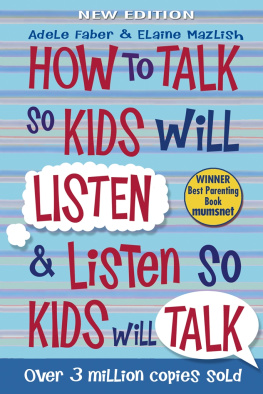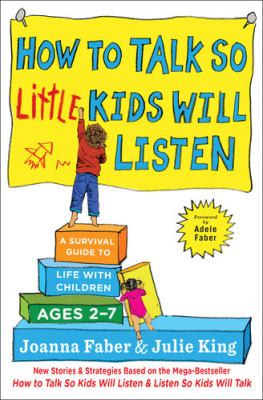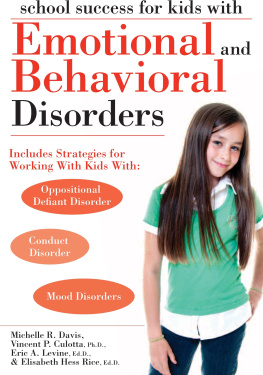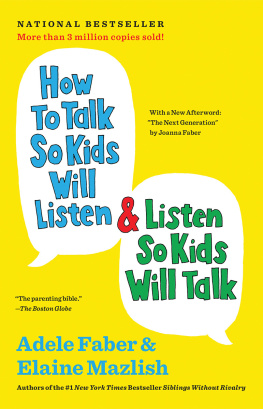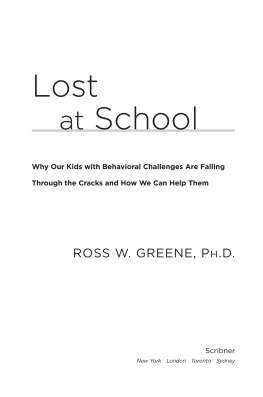Adele Faber - How to Talk So Kids Can Learn
Here you can read online Adele Faber - How to Talk So Kids Can Learn full text of the book (entire story) in english for free. Download pdf and epub, get meaning, cover and reviews about this ebook. year: 1995, publisher: Scribner Book Company, genre: Children. Description of the work, (preface) as well as reviews are available. Best literature library LitArk.com created for fans of good reading and offers a wide selection of genres:
Romance novel
Science fiction
Adventure
Detective
Science
History
Home and family
Prose
Art
Politics
Computer
Non-fiction
Religion
Business
Children
Humor
Choose a favorite category and find really read worthwhile books. Enjoy immersion in the world of imagination, feel the emotions of the characters or learn something new for yourself, make an fascinating discovery.

- Book:How to Talk So Kids Can Learn
- Author:
- Publisher:Scribner Book Company
- Genre:
- Year:1995
- Rating:3 / 5
- Favourites:Add to favourites
- Your mark:
- 60
- 1
- 2
- 3
- 4
- 5
How to Talk So Kids Can Learn: summary, description and annotation
We offer to read an annotation, description, summary or preface (depends on what the author of the book "How to Talk So Kids Can Learn" wrote himself). If you haven't found the necessary information about the book — write in the comments, we will try to find it.
How to Talk So Kids Can Learn — read online for free the complete book (whole text) full work
Below is the text of the book, divided by pages. System saving the place of the last page read, allows you to conveniently read the book "How to Talk So Kids Can Learn" online for free, without having to search again every time where you left off. Put a bookmark, and you can go to the page where you finished reading at any time.
Font size:
Interval:
Bookmark:
The many people who believed in this book from the beginning helped it become a reality. Family and friends gave ongoing input and encouragement. Parents, teachers, and mental health professionals throughout the United States and Canada provided verbal and written accounts of how they had put communications skills into action at home and at work. Joanna Faber gave us many moving examples drawn from her ten years of teaching in an inner-city school. Bradley University and Brattain Elementary School lent their facilities and support. Kimberly Ann Coe, our illustrator, once again wrought her magic by taking our stiff stick figures and endowing them with life and warmth. Bob Markel, our literary agent, was always there for us with the right advice at the right time. Eleanor Rawson, our publisher, deftly and lovingly guided us to where she knew we had to go.
Finally, we wish to acknowledge Dr. Thomas Gordon for his original work in the field of adult-child relationships and, of course, our mentor, the late Dr. Haim Ginott. It was he who helped us understand why every teacher should be, first, a teacher of humanity, and then a teacher of his subject.
Bluestein, Jane. Twenty-first-Century Discipline. Jefferson City, Mo.: Scholastic, 1988.
Branden, Nathaniel. The Six Pillars of Self-Esteem. New York: Bantam Books, 1994.
Elkind, David, Ph.D. Parenting Your Teenager in the Nineties. Rosemont, N.J.: Modern Learning Press, 1993.
Faber, Adele, and Elaine Mazlish. How to Talk So Kids Will Listen and Listen So Kids Will Talk. New York: Rawson, Wade Publishers, Inc., 1980.
. Siblings Without Rivalry. New York: W.W. Norton & Company, 1987.
Gardner, Howard. Frames of Mind: The Theory of Multiple Intelligence. New York: Basic Books, 1993.
Garrity, Carla, Ph.D. Bully-Proofing Your School. Longmont, Co.: Sopris West, 1994.
Ginott, Haim G. Teacher and Child. New York: Avon Books, 1970.
Gordon, Thomas. Teaching Children Self-Discipline at Home and in School. New York: Random House, 1989.
. Teacher Effectiveness Training. New York: Peter H. Wyden, 1974.
Healy, Jane M. Is Your Bed Still There When You Close the Door? And Other Playful Ponderings. New York: Doubleday, 1992.
Hyman, Irwin A. Reading, Writing, and the Hickory Stick. Lexington, Mass.: Lexington Books, 1990.
Kohn, Alfie. Punished by Rewards. Boston: Houghton Mifflin Company, 1993.
Kurcinka, Mary Sheedy. Raising Your Spirited Child. New York: HarperCollins, 1991.
Levin, Diane. Teaching Young Children in Violent Times: Building a Peaceable Classroom. Cambridge, Mass.: Educators for Social Responsibility, 1994.
Webster-Doyle, Terrence. Why Is Everybody Always Picking on Me? Middlebury, Vt: Atrium Society Publications, 1991.
Wlodkowski, Raymond J., and Judith H. Jaynes. Eager to Learn: Helping Children Become Motivated and Love Learning. San Francisco: Jossey-Bass, 1991.
For Further Study
If you would like information about the audio or video group workshop programs for parents created by Adele Faber and Elaine Mazlish, send a stamped, self-addressed envelope to:
Faber/Mazlish Workshops,
LLC P.O. Box 64
Albertson, New York 11507
Feelings That
Interfere with
Learning
IT WAS THE MEMORIES OF MY OWN TEACHERSBOTH THOSE I LOVED AND THOSE I HATEDTHAT MADE ME decide to become one.
I had a long, mental list of all the mean things I would never say or do to my students and a clear vision of how infinitely patient and understanding I would be. All during my education courses in college, I held on to my conviction that I could teach kids in a way that would make them want to learn.
My first day as a real teacher came as a shock. As much as I had planned and prepared, I was totally unprepared for these thirty-two sixth graders. Thirty-two kids with loud voices, high energy, and powerful wants and needs. Halfway through the morning the first rumblings began: Who stole my pencil?! Get out of my face! Shut up. Im tryin to listen to the teacher!
I pretended not to hear and went on with the lesson, but the eruptions continued: Why do I have to sit next to him? I dont understand what were supposed to do. He punched me! She started it!
My head began to pound. The noise level in the room continued to rise. Words of patience and understanding died on my lips. This class needed a teacher who was in charge and in control. I heard myself saying:
Cut it out. Nobody stole your pencil.
You have to sit next to him because I said so.
I dont care who started it. I want it ended. Now!
What do you mean you dont understand? I just explained it.
I cant believe this class. Youre acting like first graders. Will you please sit still!
One boy ignored me. He left his seat, walked over to the sharpener, and stood there grinding his pencil to a nub. In my firmest voice I ordered, Thats enough! Sit down right now!
You cant make me do nothin, he said.
Well talk about this after school.
I cant stay. I ride the bus.
Then Ill need to call your parents to get this settled.
You cant call my parents. We dont got no phone.
By three oclock I was exhausted. The kids burst out of the classroom and spilled out onto the streets. More power to them. They were their parents responsibility now. Id done my time.
I slumped in my chair and stared at the empty desks. What went wrong? Why wouldnt they listen? What did I have to do to get through to these kids?
All during those first few months of teaching, the pattern was the same. Id start each morning with high hopes and leave every afternoon feeling overwhelmed by the drudgery and tedium of having to drag my class through the required curriculum. But worse than anything, I was turning into the kind of teacher I never wanted to beangry, bossy, and belittling. And my students were becoming increasingly sullen and defiant. As the term wore on, I found myself wondering how long I could last.
Jane Davis, the teacher next door, came to my rescue. The day after I poured my heart out to her, she stopped by my room and handed me her worn copy of How to Talk So Kids Will Listen and Listen So Kids Will Talk. I dont know if this will help, she said, but the skills in this book saved my sanity with my own kids at home. And they sure make a difference in my classroom!
I thanked her, put the book in my briefcase, and forgot about it. A week later I was lying in bed nursing a cold. Idly I reached for the book and opened it. The italicized words on the first page jumped out at me.
Direct connection between how kids feel and how they behave.
When kids feel right, theyll behave right.
How do we help them to feel right?
By accepting their feelings!
I lay back on my pillow and closed my eyes. Did I accept my students feelings? In my head I replayed some of the exchanges Id had with the kids that week:
Student: I cant write.
Me: Thats not true.
Student: But I cant think of anything to write about.
Me: Yes, you can! Just quit complaining and start writing.
Student: I hate history. Who cares what happened a hundred years ago?
Me: You should care. Its important to know your countrys history.
Student: Its boring.
Me: No, it isnt! If you paid attention, youd find it interesting.
Font size:
Interval:
Bookmark:
Similar books «How to Talk So Kids Can Learn»
Look at similar books to How to Talk So Kids Can Learn. We have selected literature similar in name and meaning in the hope of providing readers with more options to find new, interesting, not yet read works.
Discussion, reviews of the book How to Talk So Kids Can Learn and just readers' own opinions. Leave your comments, write what you think about the work, its meaning or the main characters. Specify what exactly you liked and what you didn't like, and why you think so.

